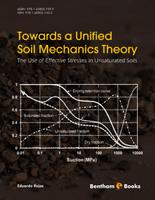Editor: Eduardo Rojas, Published on: August 08th, 2018.
This is an updated edition of the author’s comprehensive work on soil mechanics.
When Karl von Terzaghi applied the effective stress principle in the soil mechanics theory, the strength and volumetric behavior of saturated soils could be clearly understood and general constitutive models for these materials could be developed. More than fifty years ago Alan W. Bishop proposed an equation for the effective stresses of unsaturated soils. However, this equation was severely criticized because it could not explain by itself the phenomenon of collapse upon wetting of soils. In addition Bishop's effective stress parameter? showed to be extremely elusive and difficult to determine experimentally. Given these difficulties the use of the so called independent stress variables (mainly net stress and suction) became common in unsaturated soil mechanics.
Different equations for the strength and volumetric behavior of soils were proposed and the theory for unsaturated soils became distant from that of saturated materials. But then, the simulation of some particular phenomena related to the strength and volumetric behavior of unsaturated soils, appeal for the inclusion of the hysteresis of the soil-water retention curve and the hydro-mechanical coupling observed in unsaturated materials. The difficulties met in introducing these aspects into the independent stress variables models made it clear that a different approach should be considered. Then, quietly elastoplastic models based on Bishop's effective stress equation started to appear showing its superiority by including the hysteresis of the soil-water retention curve and the hydro-mechanical coupling of unsaturated soils. And finally, the debate about the appropriateness of Bishop's equation to represent the effective stresses for unsaturated soils is slowly coming to an end. This transformation on the construction of constitutive models for unsaturated soils is also leading towards a unified soil mechanics theory.
This book shows how the effective stress principle can be applied to simulate the strength and volumetric behavior of unsaturated soils employing the same equations commonly used for saturated materials. The book initiates with an analysis of the stresses transmitted to the different phases of an unsaturated soil when it is loaded. This analysis results in an expression for the stresses carried out by the solid skeleton of the material. This expression can be written in the same terms as Bishop´s effective stress equation and leads to an analytical expression for Bishop's effective stress parameter ?. However, the variables required to obtain ? cannot be experimentally determined. For that purpose, a network porous-solid model, able to approximately reproduce the structure of soils is developed.
This porous-solid model is based on the grain and pore size distributions of the material and determines the allocation of water in the pores of the soil and is able to reproduce the soil-water retention curves of the material including the scanning curves. It is also possible to obtain the required parameters to determine the value of Bishop's parameter ? and therefore compute the current effective stress. Nevertheless, the use of a network porous-solid model requires large memory storage capacity that cannot be presently found in common computers. For that reason, a probabilistic porous-solid model is developed that reduces the storage requirements and speeds the simulations. In addition, the use a porous-solid model based on the current pore size distribution of the soil, allows simulating in a very simple manner the hydro-mechanical coupling of unsaturated materials.
When effective stresses are considered, a single failure surface for any value of suction is obtained. With the addition of an elastoplastic framework, the volumetric behavior of unsaturated soils including collapsing and expansive materials can be simulated. This framework includes the phenomenon of suction hardening, which displaces the compression curves of unsaturated materials with respect to the saturated compression line. This same displacement is observed on the critical state line and results in anisotropic hardening for the yield surface in the mean effective stress axis. When all these elements are gather together, simple fully coupled models can be developed similar to those for saturated materials. In that sense, a unified soil mechanics theory is presently on its way.
About the Author
Eduardo Rojas is a consultant engineer and has participated in different engineering projects ranging from projects that dealt with the underpinning of tilted buildings, the analysis of the stability of slopes during heavy rain, to the design of deep and shallow foundation on different types of soils including expansive, collapsing, dispersive and highly compressive materials. He has published extensive research in the field. Rojas graduated as a civil engineer at the National Center of Technical and Industrial Education (CeNETI) in Mexico in 1980. He obtained his Master and PhD degrees in Soil Mechanics at the Institut de Mécanique de Grenoble (IMG), France, in 1982 and 1984, respectively. He is currently working at Universidad Autónoma de Querétaro and is a member of the National Research System (SNI) in Mexico.
Keywords: Civil Engineering, Earth Science, Geology/Soil, Hydrology/Water Resources, Technology/Engineering/Computer Science

